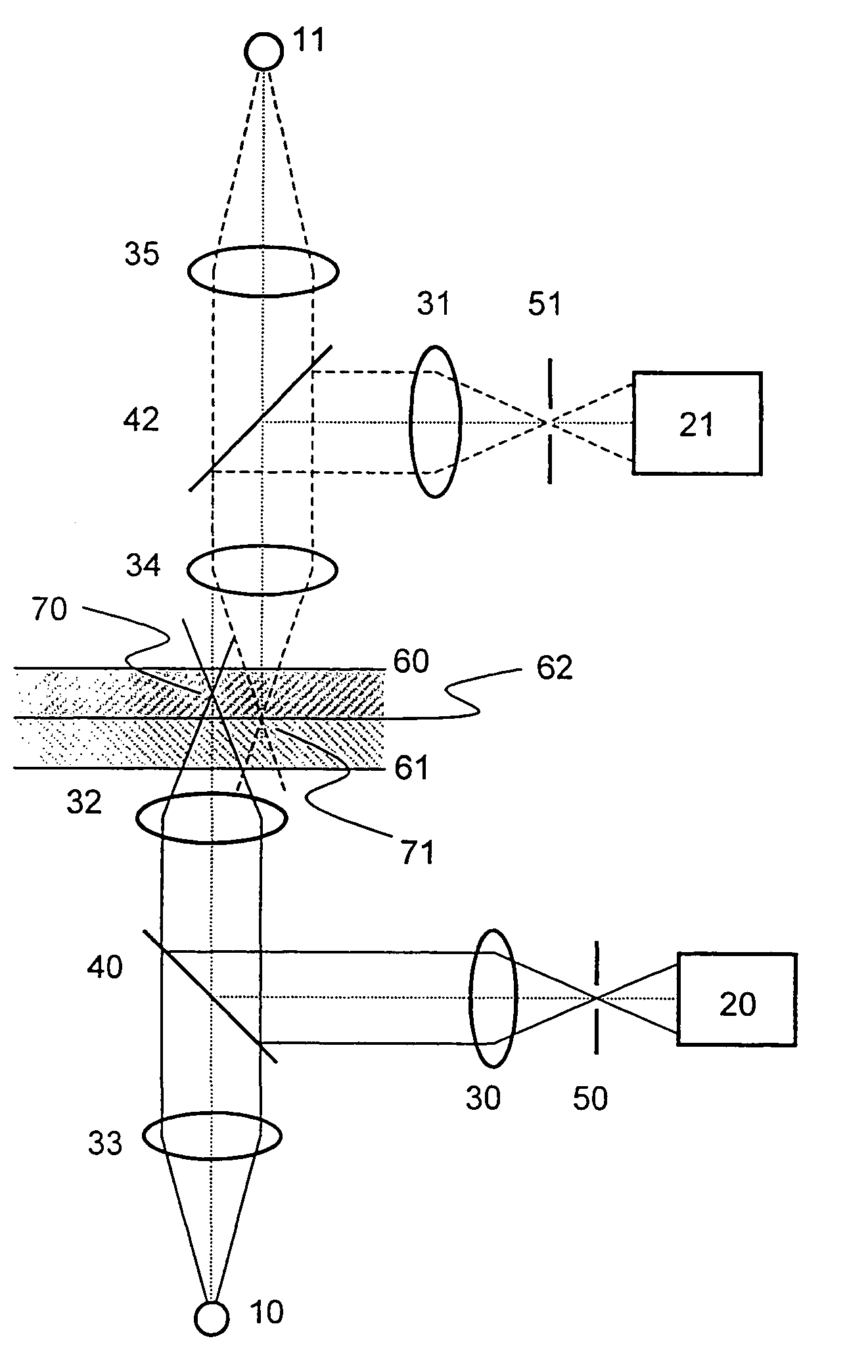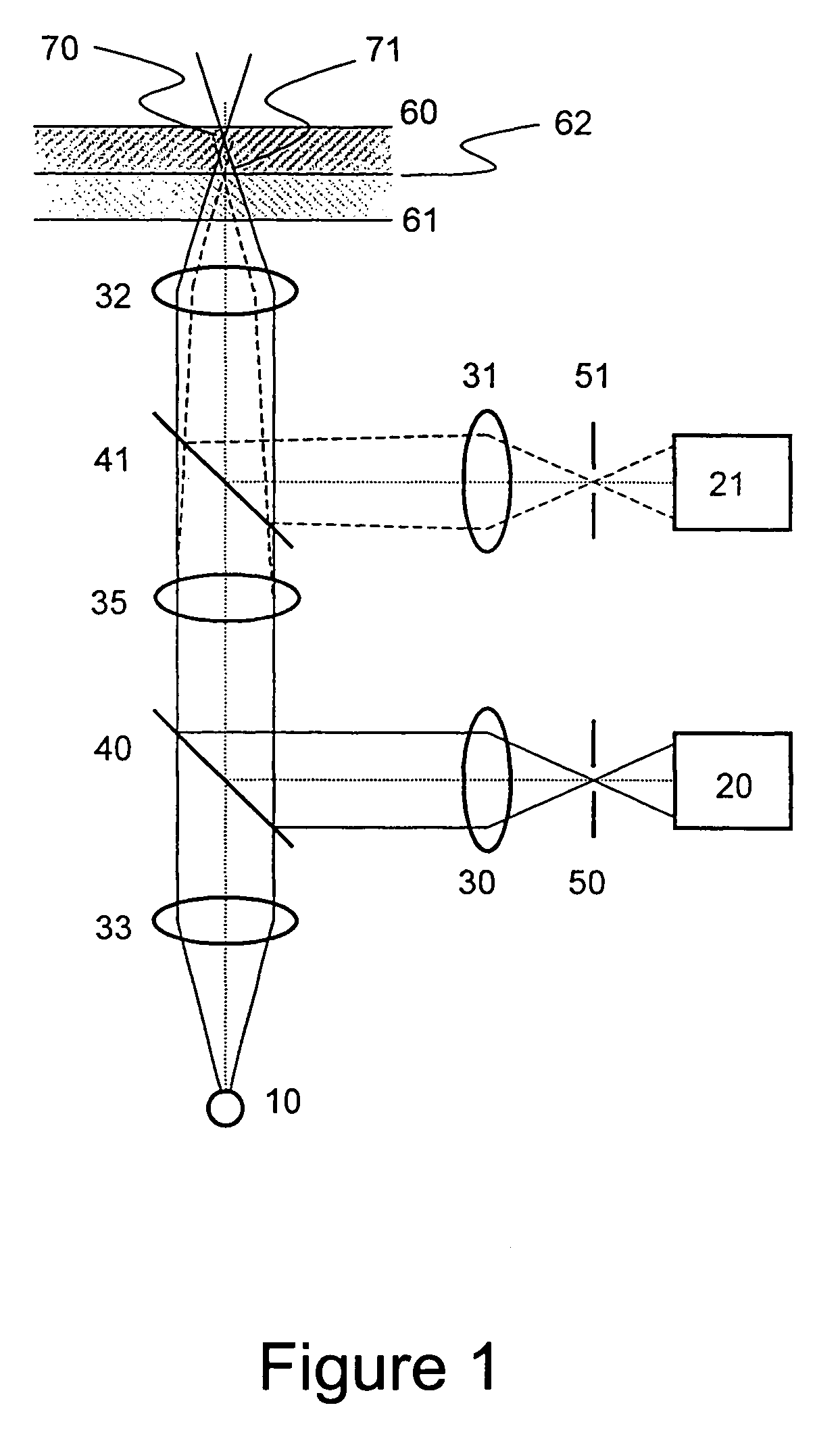Scanning microscopic method having high axial resolution
a microscopic method and high axial resolution technology, applied in the field of scanning microscopic methods with high axial resolution, can solve the problems of inability to operate the autofocus system during the actual measurement of the sample, adversely affecting the object's registration and characterization, and extremely time-consuming procedures, and achieve high axial resolution and reliable detection.
- Summary
- Abstract
- Description
- Claims
- Application Information
AI Technical Summary
Benefits of technology
Problems solved by technology
Method used
Image
Examples
example 1
[0061]The present example substantially corresponds to the arrangement shown in FIG. 6. A semiconductor laser 11 having a power of 3 mW and a wavelength of 780 nm is used as radiation source for generating the auxiliary focus 71. The output radiation of the laser 11 is directed to an optical fiber Y-coupling 42 by a monomode-glasfiber 81. Another monomode-glasfiber 80 at the exit of coupling 42 serves for supplying the radiation for the auxiliary focus 72 as well as for confocal detection of the light reflected at the interface 62.
[0062]An achromatic lens 31 having a focus of 40 mm serves for bundling the applied or detected radiation, respectively. The convergence of the ray bundles directed to the objective 32 and thereby the position of the auxiliary focus 71 relative to the measuring volume 70 can be variated by changing the distances between the free end of the fiber 80 and the achromatic lens 31 by lens mover portion 85. In the described embodiment the distance between measuri...
example 2
[0066]In the present example so called tenta-gel™—beads of the type S PHB-Gly (RAPP polymers) are used for the substrate. Those are conjugated with theophylline-molecules (Aldrich) as entities. The charging of the beads is 9%. 5 mg of the beads are suspended in 444 μl PBS-puffers. Lab-tek chambered coverglasses, #1 borosilicate, septic, 8-well (Nunc Nalge International, Lot. No. 148116-0605) are used as sample supports. A polyclonal rabbit anti-theopyllin-antibody (Europa Research, Lot. No. 80 17 15) is used as first antibody. A fluorescently marked (TRITC, Tetra-methylrhodamine-5-(and 6)-isothiocyanate) anti-rabbit-IgG-antibody (DAKO, Lot. No. 077(101)) serves as second antibody. The assay buffer, called TNT in the following, consists of: 50 mM Tris-HCl pH 7,5, 100 mM NaCl, 0,01% Tween-20.
[0067]The assay is done as follows: 8 μl bead suspension are mixed with 100 μl of a 1:2000 dilution of the first antibody and shaken for 30 minutes at room temperature. After that, the twice repea...
PUM
 Login to View More
Login to View More Abstract
Description
Claims
Application Information
 Login to View More
Login to View More - R&D
- Intellectual Property
- Life Sciences
- Materials
- Tech Scout
- Unparalleled Data Quality
- Higher Quality Content
- 60% Fewer Hallucinations
Browse by: Latest US Patents, China's latest patents, Technical Efficacy Thesaurus, Application Domain, Technology Topic, Popular Technical Reports.
© 2025 PatSnap. All rights reserved.Legal|Privacy policy|Modern Slavery Act Transparency Statement|Sitemap|About US| Contact US: help@patsnap.com



